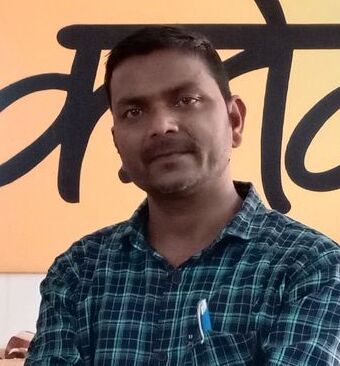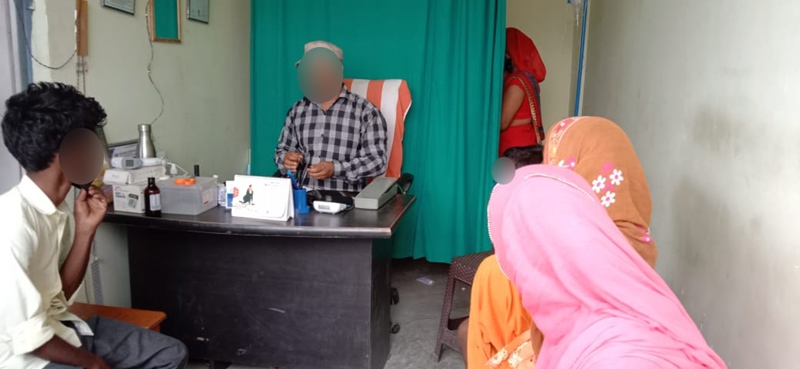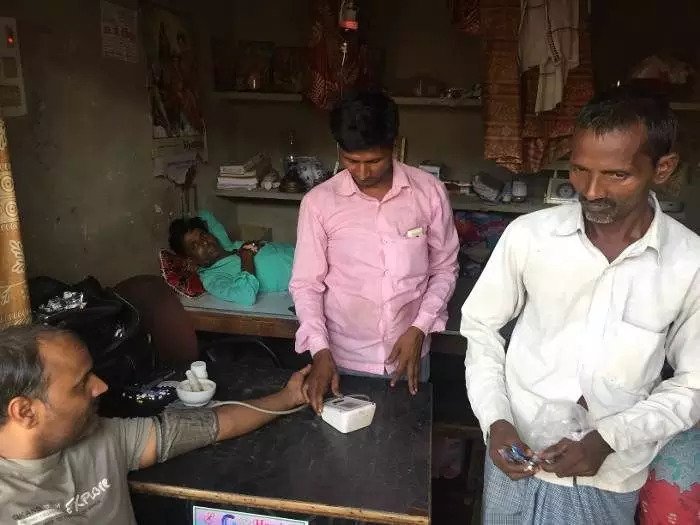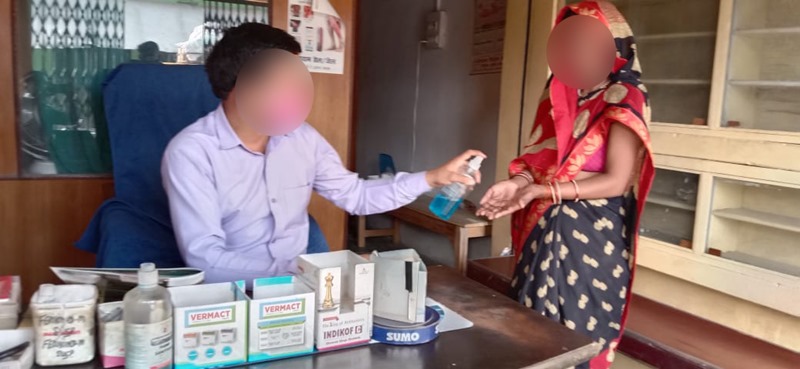“I may be a jhola chaap, but I help villagers in their times of distress”
As the second wave of the COVID 19 pandemic hit the villages in the country, it also exposed the woeful inadequacies of the rural PHCs. In such a time, the villagers reposed their trust in the jhola chaap, for treatment of various ailments. Meet Rajesh Kumar, who runs a ‘clinic’ in Barabanki, Uttar Pradesh.


“Usually, I would see ten to twenty patients a day, but now I have nearly hundred patients showing up every day,” said the quack. All photos: Gaon Connection
Barabanki, Uttar Pradesh
He is ‘Doctor saab’, ‘Doctor bhaiyya’, or even plain ‘Doctor chacha’ to many villagers. They have known him all their lives, they are neighbours, and he is the one they turn to in times of a common ailment.
But, he is not a regular, ‘MBBS’ qualified doctor. He is at best a pharmacist perhaps, a compounder or someone who knows just enough about treating a common cold, a fever or a cough. He may throw in some homegrown remedies too.
Rajesh Kumar is one such ‘doctor’, a rural medical practitioner who is often referred to as a ‘jhola chaap’ (quack). With the rural healthcare system in the country in doldrums and villagers having little faith in the formal health setup, it is the jhola chaaps like Kumar whom the rural citizens have turned to in the pandemic.
“They may call us what they want, but in the pandemic, god knows how many of us jhola chaaps have worked day and night to serve the ill,” Kumar, who runs a ‘clinic’ in a small town in Barabanki district of Uttar Pradesh, told Gaon Connection.
According to him, many doctors have shut down their private practice because of the fear of coronavirus, and big private hospitals have become COVID19 centres. “In such times, the villagers are coming to us and we are treating them to the best of our abilities,” Kumar assured.
He has been running the small clinic for about ten years now. “And I have never seen so many people fall ill. In the second wave, entire villages were affected by colds, coughs and fevers,” 46-year-old Kumar said.
“Usually, I would see ten to twenty patients a day, but in the second wave, there have been days when I have nearly hundred patients showing up at my clinic every day,” Kumar said, who charges a consultation fee of up to Rs 20 a patient.

Also Read: “I have to wait for nine months to be paid Rs 600 incentive for one delivery”
Before the pandemic, the rural medical practitioner said he would earn between Rs 200 and Rs 400 a day on an average, but now he easily earns up to Rs 800 a day.
Long hours at work
Rajesh Kumar opens his clinic at 7 am and almost immediately he starts seeing people. His clinic remains open till 11 pm for 16 hours a day.
“Sometimes there are people already waiting for me,” he told Gaon Connection as he arranged his striped towel on the back of his chair, tweaked the green curtain behind which was a narrow cot where he examined patients if required and sat down.
A plastic box with odds and ends was kept on the side, with a scissor on top, next to a table calendar. Kumar walks to his clinic as it is just around the corner from his home.
On May 28, when Gaon Connection met Kumar at his clinic, two women sat with their feet up on a wide bench next to his table and waited patiently for his attention.

“I get home late and sometimes I wouldn’t even have taken a break for a meal or a cup of tea,” Rajesh Kumar said. There are times when he is woken up in the middle of the night because someone has suddenly taken ill.
Also Read: Rajiv Singh Yadav, a ration shop kotedaar, defies the ‘bad guy’ stereotype
During the pandemic, almost every household had a member of the family ill with fever, cough or cold, the rural medical practitioner said. “The primary health centres were focussed only on COVID patients and even the district hospital outpatient department was not entertaining anyone,” said Kumar.
Lingering fear
Between the almost continuous stream of villagers coming, some complaining of a sore throat, someone else saying they had a headache and yet others coming there to get minor burns and boils treated, Kumar said like everyone else in the country, he too was scared of the pandemic.
“At the back of my mind is always that anxiety that I should not carry back an infection home,” he told Gaon Connection. He said while in big hospitals and clinics the doctor ‘saw’ the patient from a safe distance, there was no scope of doing that in his own clinic, a small room with his table, a narrow space behind that where he examines his patients and a bench, with little space to move around in between.

Also Read: On two legs and a prayer, without proper safety gear, ASHAs conduct door-to-door COVID screening in rural UP
“These are people I know. I have to help them lie down and get up from the examination table,” said the ‘doctor’.
Rajesh Kumar’s wife is six months pregnant. “Because of that, I stay in a separate room outside the house, away from the family,” he said. It was difficult to ignore the continuous din on television, radios and the newspaper about the number of doctors who have died treating COVID patients, he said.
Why villagers reach out to jhola chaaps
“I can’t remember when I last had a full night of uninterrupted sleep without someone knocking on my door,” Kumar said and turned to ask his next patient Rajkumari who was waiting there patiently what her problem was.
“I have come to collect my medicine for fever,” the 60-year-old from the nearby Sauranga village, told him. “In my family, whenever anyone falls ill, we always come here,” Rajkumari told Gaon Connection, and added that for so many years, no medicine he has given has harmed them.

“Where will we find the money to go to a big hospital in the city or a private clinic? Here my job is done and I spend anything between ten and fifty rupees including medicines. Elsewhere, just getting there will cost me that much,” Rajkumari said, as she left the clinic clutching the medicines ‘Doctor saab’ had given her.
“Even if it is midnight we don’t have to hesitate to come here,” Anu Soni, from the same village, told Gaon Connection. “We do not have the money to go to a big doctor. Where do we get the money to pay two to three hundred rupees to them,” she asked.
Soni had come to pick up medicines to treat her son’s diarrhea and, she too said that ever since her son was born eight years ago, it has been Rajesh Kumar who they have turned to for medical help.
Villagers’ preference for jhola chaaps isn’t limited to Kumar or other rural medical practitioners in Uttar Pradesh. A recent survey of 300 respondents by Transform Rural India Foundation in Jhabua, Madhya Pradesh, found 38 per cent respondents preferred quacks for treatment, commonly known as nadi babas.
“The rural medical practitioner remains the de facto doctor of choice for routine healthcare needs or any minor emergency. The formal private providers in the urban area are also often favoured, but the astronomical cost of treatment often acts as a deterrent,” Vikash R Keshri, a Senior Research Fellow at the George Institute for Global Health, India at New Delhi, recently wrote in Gaon Connection.
Meanwhile, with the second wave ebbing, Kumar is in a pensive mood. “I will never forget the days of the pandemic. When it is all over and I look back, I will remember the sleepless nights, the missed meals and midnight knocks on my door,” he said. “I may be a jhola chaap, but I help my fellow villagers in their times of distress,” he concluded.
Name of the ‘doctor’ in the story has been changed on his request.

